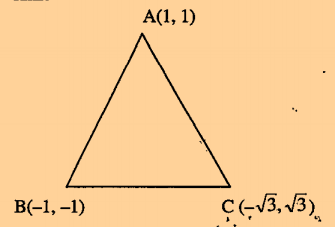Show that the points (1,1),(-1,-1) and (−√3,√3) are the vertices of an equilateral triangle.Solution in Odia

∴∣∣¯¯¯¯¯¯AB∣∣=√(−1−1)2+(−1−1)2=2√2 Slope of
∣∣¯¯¯¯¯¯BC∣∣√(−1+√3)2+(−1−√3)2
= √2(1+3)=2√2
∣∣¯¯¯¯¯¯AC∣∣=√(1+√3)2+(1−√3)2
= sqrt(2)(1+3) = 2sqrt2<br>therefore barAB = barBC = barAC<br>therefore ABC is an equilateral triangle.
Topper's Solved these Questions
Similar Questions
If the values observed are 1,2,…..,n each with frequency 1, find the mean value
View SolutionThe number of lines making equal angles with coordinate axes is_____.
View SolutionInradius of the triangle with vertices (1,1), (-1,-1), (-sqrt3, sqrt3) is
View SolutionShow that points (2−√3,√3+1),(1,0) and (3,2) form an equilateral triangle .
View SolutionShow that the points A(1, 1), B(-1, -1) and C(−√3,√3) are the vertices of an equilateral triangle each of whose sides is 2√2 units.
View SolutionThe area of the triangle formed by three point √3+i,−1+√3iand(√3−1)+(√3+1)i is ________
View SolutionShow that the points (2a, 6a) (2a,4a) and (2a+√3a,5a)are the vertices of an equilateral triangle of side 2a units.
View SolutionShow that the points 1,−12+i√32,and−12−i√32 are the vertices of an equilateral triangle.
View SolutionShow that the following sets of points are the vertices of an equilateral triangle :- (1, 1),(- 1,-1) and (−√3,√3) .
View SolutionThe equation to the base of an equilateral triangle is (√3+1)x+(√3−1)y+2√3=0 and opposite vertex is A(1,1) then the Area of the trangle is
View SolutionProve that the points O(0,0,0),A(2.0,0),B(1,√3,0)andC(1,1√3,2√2√3) are the vertices of a regular tetrahedron.,
View SolutionThe area of the triangle formed by three point √3+i,−1+√3iand(√3−1)+(√3+1)i is ________
View SolutionProve that A(1, 1), B(-1,-1),C(−√3,√3)are the points of vertices of an equilateral triangle.
View SolutionAn equilateral triangle has one vertex at (-1 , -1) and another vertex at (−√3,√3) The third vertex may lie on
View SolutionProve that the point A (0,0,0),B(2,0,0), C(1,sqrt3,0) and D(1,1/sqrt3, (2sqrt2)/sqrt3) are the vertices of a regular tetrahedron.
View Solution
